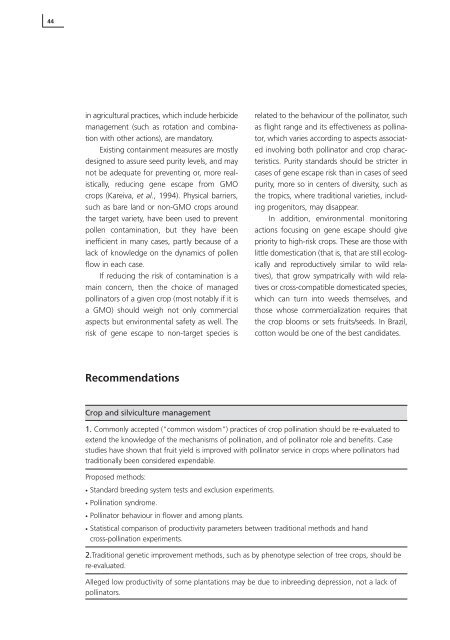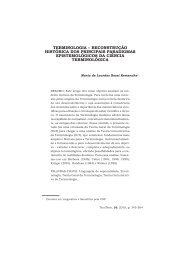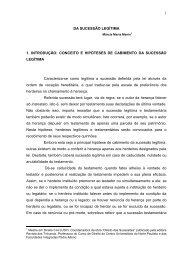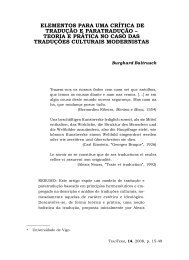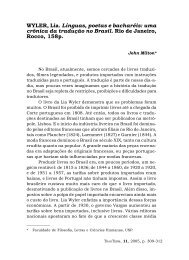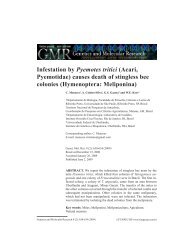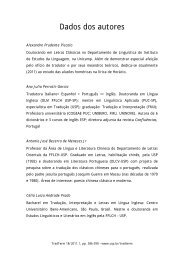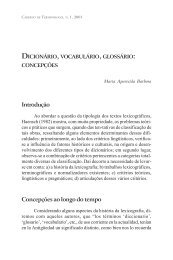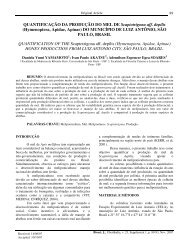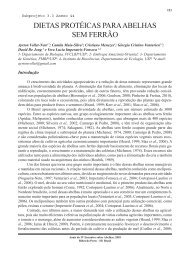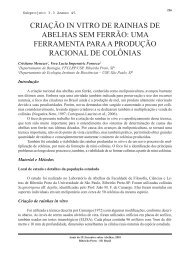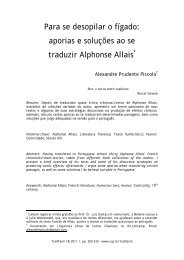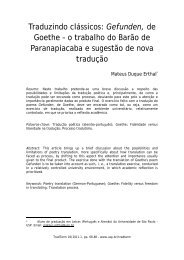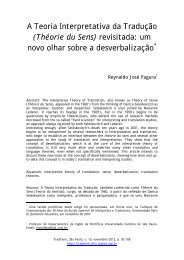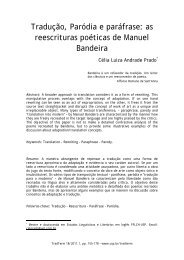Bees as pollinators in Brazil - USP
Bees as pollinators in Brazil - USP
Bees as pollinators in Brazil - USP
Create successful ePaper yourself
Turn your PDF publications into a flip-book with our unique Google optimized e-Paper software.
44<br />
<strong>in</strong> agricultural practices, which <strong>in</strong>clude herbicide<br />
management (such <strong>as</strong> rotation and comb<strong>in</strong>ation<br />
with other actions), are mandatory.<br />
Exist<strong>in</strong>g conta<strong>in</strong>ment me<strong>as</strong>ures are mostly<br />
designed to <strong>as</strong>sure seed purity levels, and may<br />
not be adequate for prevent<strong>in</strong>g or, more realistically,<br />
reduc<strong>in</strong>g gene escape from GMO<br />
crops (Kareiva, et al., 1994). Physical barriers,<br />
such <strong>as</strong> bare land or non-GMO crops around<br />
the target variety, have been used to prevent<br />
pollen contam<strong>in</strong>ation, but they have been<br />
<strong>in</strong>efficient <strong>in</strong> many c<strong>as</strong>es, partly because of a<br />
lack of knowledge on the dynamics of pollen<br />
flow <strong>in</strong> each c<strong>as</strong>e.<br />
If reduc<strong>in</strong>g the risk of contam<strong>in</strong>ation is a<br />
ma<strong>in</strong> concern, then the choice of managed<br />
<strong>poll<strong>in</strong>ators</strong> of a given crop (most notably if it is<br />
a GMO) should weigh not only commercial<br />
<strong>as</strong>pects but environmental safety <strong>as</strong> well. The<br />
risk of gene escape to non-target species is<br />
Recommendations<br />
Crop and silviculture management<br />
related to the behaviour of the poll<strong>in</strong>ator, such<br />
<strong>as</strong> flight range and its effectiveness <strong>as</strong> poll<strong>in</strong>ator,<br />
which varies accord<strong>in</strong>g to <strong>as</strong>pects <strong>as</strong>sociated<br />
<strong>in</strong>volv<strong>in</strong>g both poll<strong>in</strong>ator and crop characteristics.<br />
Purity standards should be stricter <strong>in</strong><br />
c<strong>as</strong>es of gene escape risk than <strong>in</strong> c<strong>as</strong>es of seed<br />
purity, more so <strong>in</strong> centers of diversity, such <strong>as</strong><br />
the tropics, where traditional varieties, <strong>in</strong>clud<strong>in</strong>g<br />
progenitors, may disappear.<br />
In addition, environmental monitor<strong>in</strong>g<br />
actions focus<strong>in</strong>g on gene escape should give<br />
priority to high-risk crops. These are those with<br />
little domestication (that is, that are still ecologically<br />
and reproductively similar to wild relatives),<br />
that grow sympatrically with wild relatives<br />
or cross-compatible domesticated species,<br />
which can turn <strong>in</strong>to weeds themselves, and<br />
those whose commercialization requires that<br />
the crop blooms or sets fruits/seeds. In <strong>Brazil</strong>,<br />
cotton would be one of the best candidates.<br />
1. Commonly accepted ("common wisdom") practices of crop poll<strong>in</strong>ation should be re-evaluated to<br />
extend the knowledge of the mechanisms of poll<strong>in</strong>ation, and of poll<strong>in</strong>ator role and benefits. C<strong>as</strong>e<br />
studies have shown that fruit yield is improved with poll<strong>in</strong>ator service <strong>in</strong> crops where <strong>poll<strong>in</strong>ators</strong> had<br />
traditionally been considered expendable.<br />
Proposed methods:<br />
• Standard breed<strong>in</strong>g system tests and exclusion experiments.<br />
• Poll<strong>in</strong>ation syndrome.<br />
• Poll<strong>in</strong>ator behaviour <strong>in</strong> flower and among plants.<br />
• Statistical comparison of productivity parameters between traditional methods and hand<br />
cross-poll<strong>in</strong>ation experiments.<br />
2.Traditional genetic improvement methods, such <strong>as</strong> by phenotype selection of tree crops, should be<br />
re-evaluated.<br />
Alleged low productivity of some plantations may be due to <strong>in</strong>breed<strong>in</strong>g depression, not a lack of<br />
<strong>poll<strong>in</strong>ators</strong>.


